Want to make spaghetti bolognese like Gordon Ramsay? It took some research and testing to find out how he approaches this classic dish, but the results are incredible.

Naturally, when researching the question, "how does Gordon Ramsay make bolognese?", I headed over to my cookbook shelf, but as far as I can tell, the chef never put spaghetti bolognese in any of his cookbooks. There's a recipe for a quick sausage meat bolognese with tagliatelle in Gordon Ramsay's Ultimate Cookery Course, but no standard bolognese - with or without spaghetti!
Now, you might argue that there's no spaghetti bolognese documented because it's not an authentic Italian dish. Spaghetti, you see, is thin and round, meaning it doesn't hold sauce well and isn't considered the correct pasta to serve with a meat sauce, also known as a ragù. However, spaghetti bolognese is of course a very popular dish in Britain and appears on dinner tables throughout the UK, so I was not to be deterred.
A bit of Googling and it turned out that in 2008, Gordon Ramsay did a cookalong on Channel 4 and during an episode, he cooked...bolognese. Hurrah! But there was a problem. While chances are the recipe did appear somewhere online during the show's broadcast, it seems to have since been lost to the sands of time.
Not to be deterred, I sat down with a pen, paper and my beady little eye (well-honed as a recipe developer) and watched the cookalong video closely. I took note of everything used in the recipe, estimated the quantities, scribbled down every step of the method Chef Ramsay used and then went about testing and retesting the sauce to make sure it hit the spot. It does!

There are a few really interesting elements in the way Gordon Ramsay makes spaghetti bolognese. For example, when Italians make a meaty sauce (ragù) for pasta, they usually start with a soffritto, which involves finely chopping carrot, onion and celery and sweating slowly in olive oil to produce a rich, delicious base for the sauce.
In this recipe however, Gordon Ramsay skips the celery and instead grates the carrot and onion, meaning the pieces are really fine and sweat down over a medium heat in a couple of minutes. It will no doubt have Italians throwing their hands in the air, but it's a clever trick if you're in a hurry.

From there on, things return to a slightly more standard approach. We add garlic, oregano, lean beef mince, tomato puree, red wine and, of course, tomatoes. Each stage involves cooking off to ensure there's no metallic acidity from the tomatoes.
There's a dash of Worcestershire sauce in this recipe which, while not traditionally, authentically Italian, is quite common in British versions of bolognese and helps to develop a lovely deep flavour.
After simmering the sauce, Chef Ramsay adds a final ingredient that may shock British and Italian alike. So, what is this final, surprise ingredient? It's milk! Ramsay explains that it helps make the sauce silky. It also helps cut through any remaining acidity in the sauce.

I've made this sauce three times now, carefully ensuring the balance is correct, and I have to say I take my hat off to Gordon, it's a great way to make spaghetti bolognese.
I must stress once more, Gordon's exact recipe doesn't seem to exist in written form anywhere on the internet and he doesn't give quantities in the 2008 video. This is my best attempt to make spaghetti bolognese Gordon Ramsay style, staying as true to his advice as possible and using my cooking knowledge to fill in the gaps to produce the best spaghetti bolognese.
Ingredients
- 1 tbsp olive oil
- ½ (1/2) onion grated (about 100g/3.5oz)
- 1 carrot grated (about 100g/3.5oz)
- 4 cloves garlic minced
- 2 tsp dried oregano
- 500 g (1.1 lb) lean beef mince
- 2 tbsp tomato puree
- 150 ml (5.1 floz) red wine
- 800 g (1.8 lb) canned chopped tomatoes
- 2 tsp Worcestershire sauce
- 4 tbsp whole milk
- pinch salt and black pepper
- 300 g (10.6 oz) dried spaghetti
Instructions
Heat the oil in a large non-stick pan over medium heat.
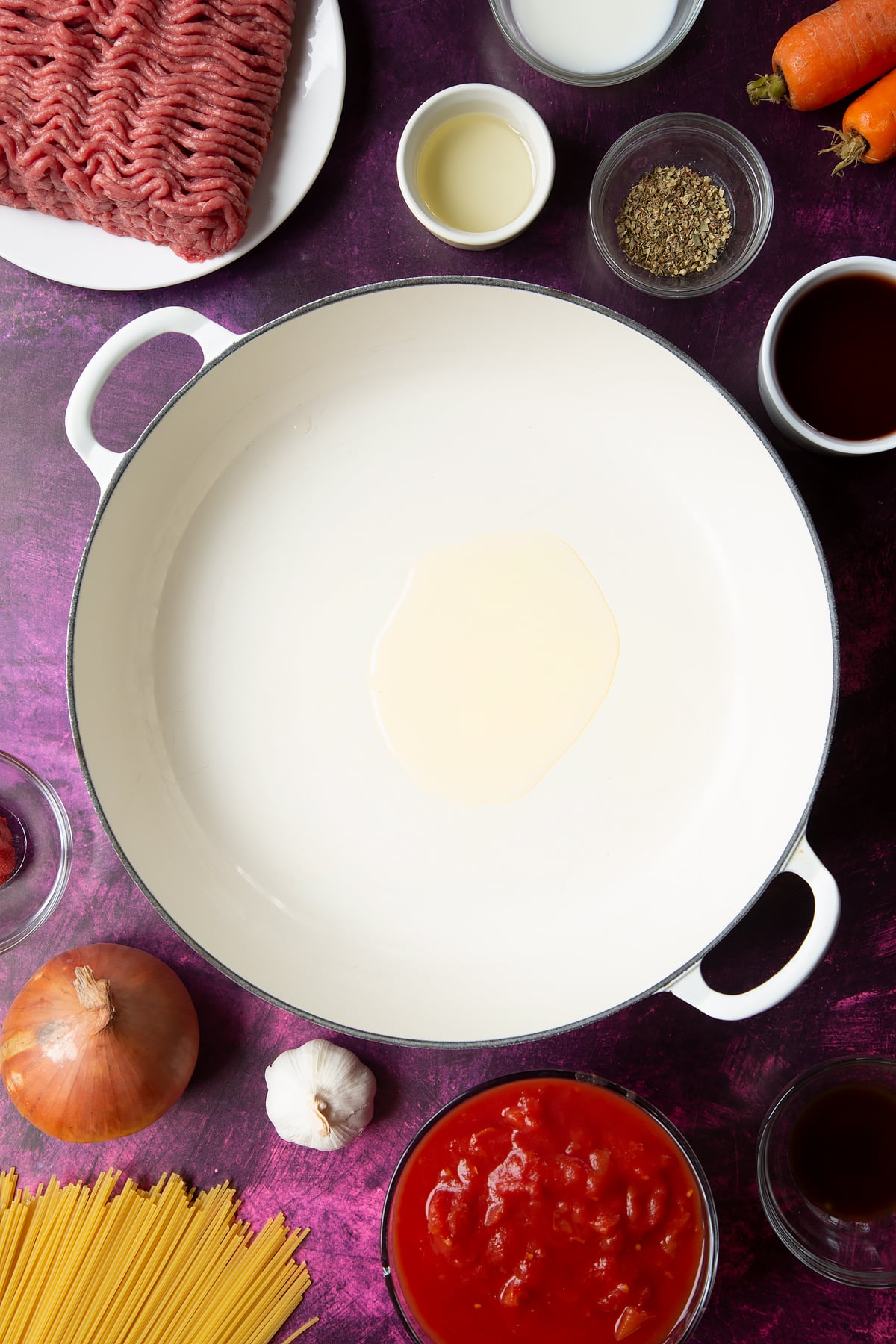
Add the carrot and onion.

Give it a stir then add the garlic, oregano and a pinch of salt and pepper.
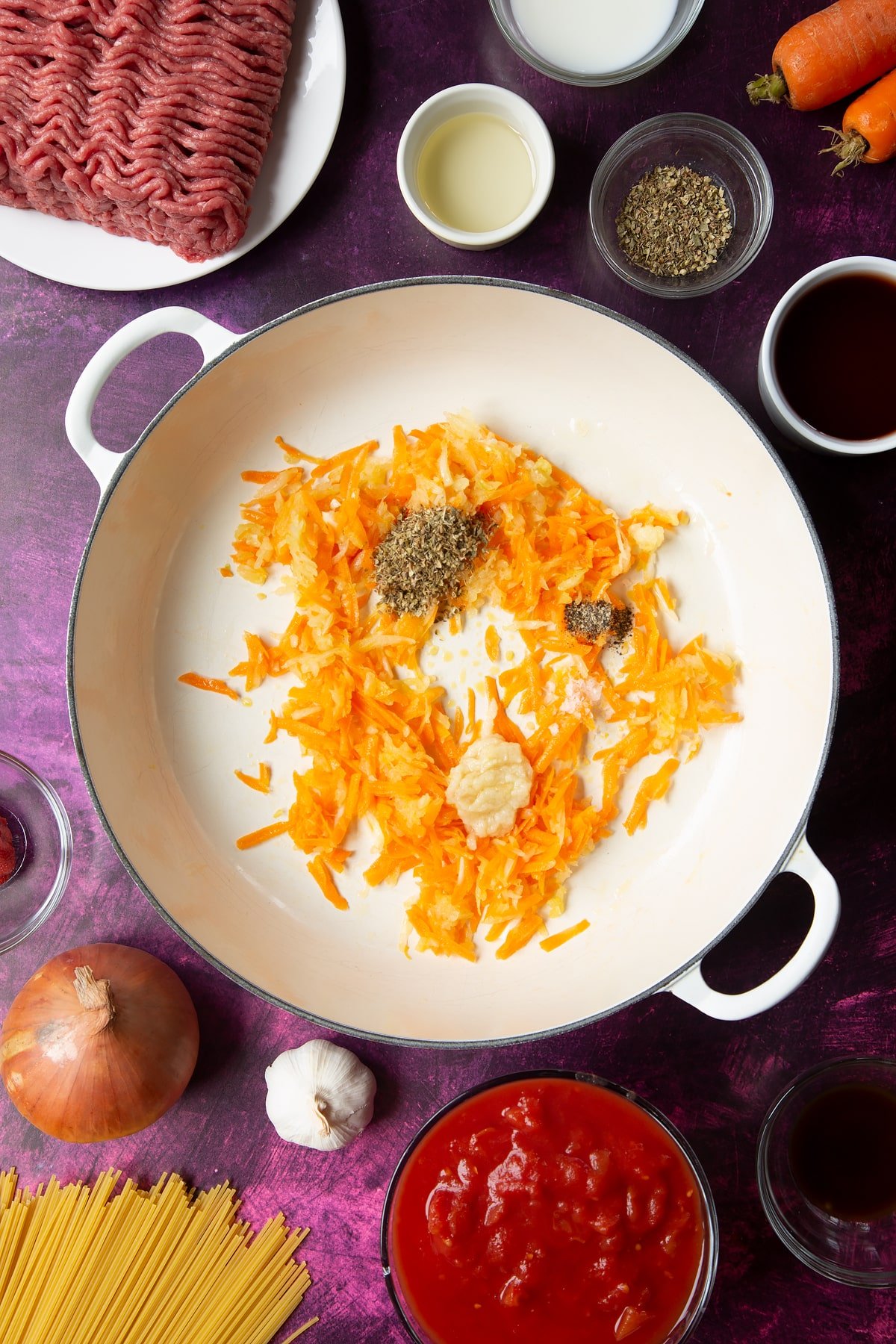
Sweat the vegetables off, stirring regularly for around 2 minutes until soft (almost paste-like) but not browned.

Make a well by pushing the veggies to the sides of the pan. This allows the heat to get right to the mince once you add it.

Add the beef mince.

Stir the mince, frying for 2-3 minutes until it’s mostly browned.

Make a well again and add the tomato puree.

Stir for 30 seconds to allow the puree to cook off a little - that gets rid of the metallic taste, then stir everything together.
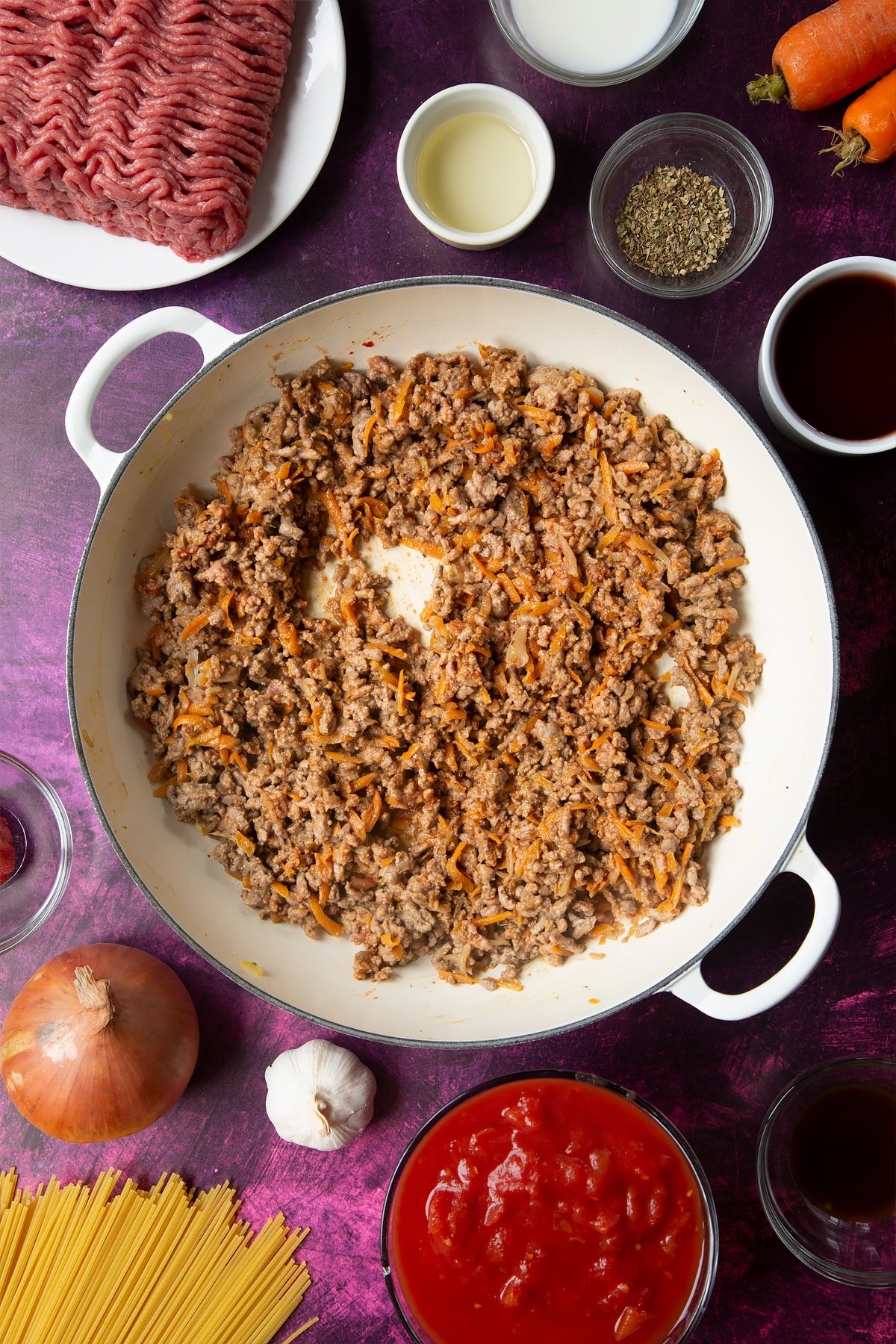
Add the red wine.
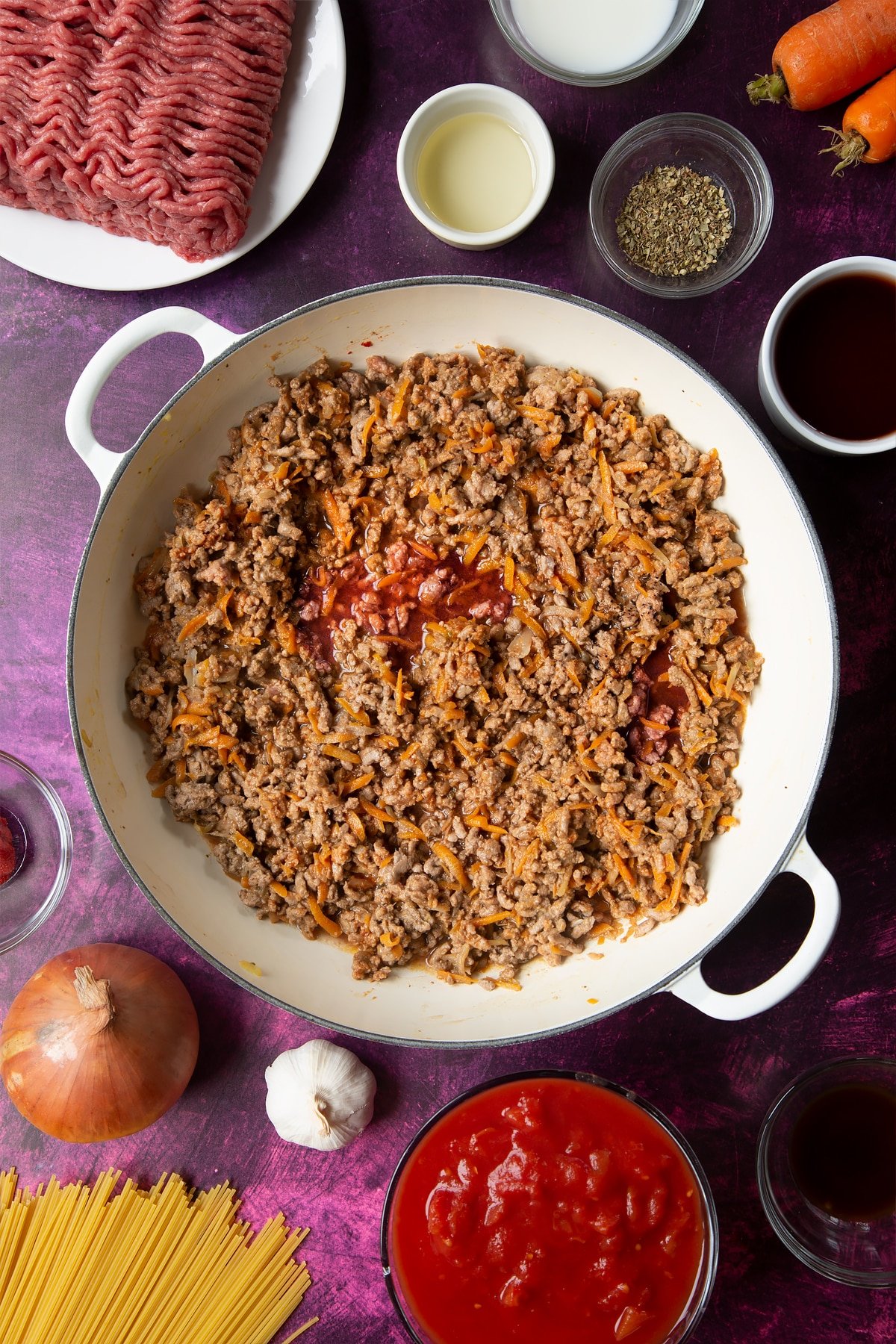
Cook for a couple of minutes until the wine reduces to a syrup.
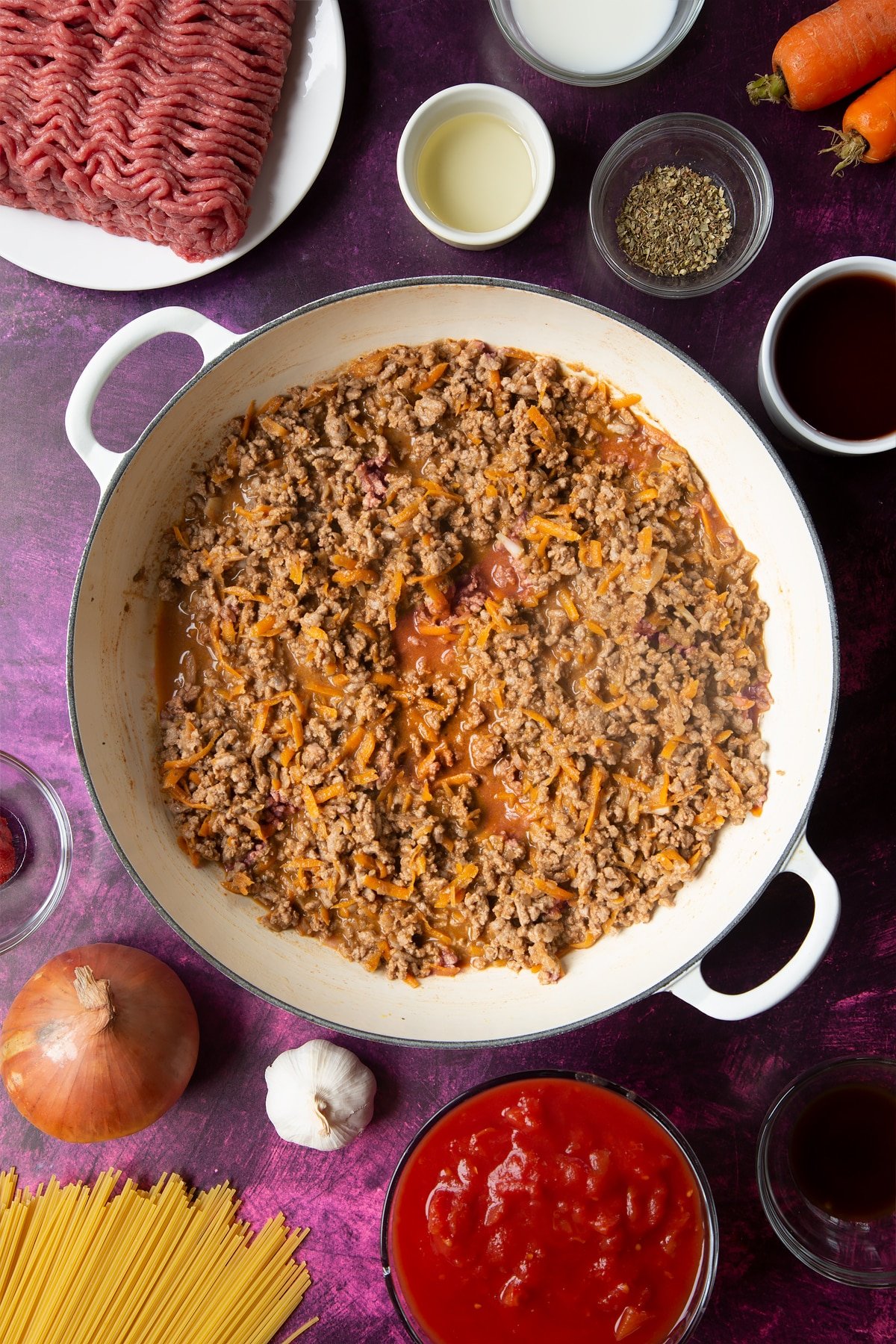
Add the tomatoes and Worcestershire sauce.
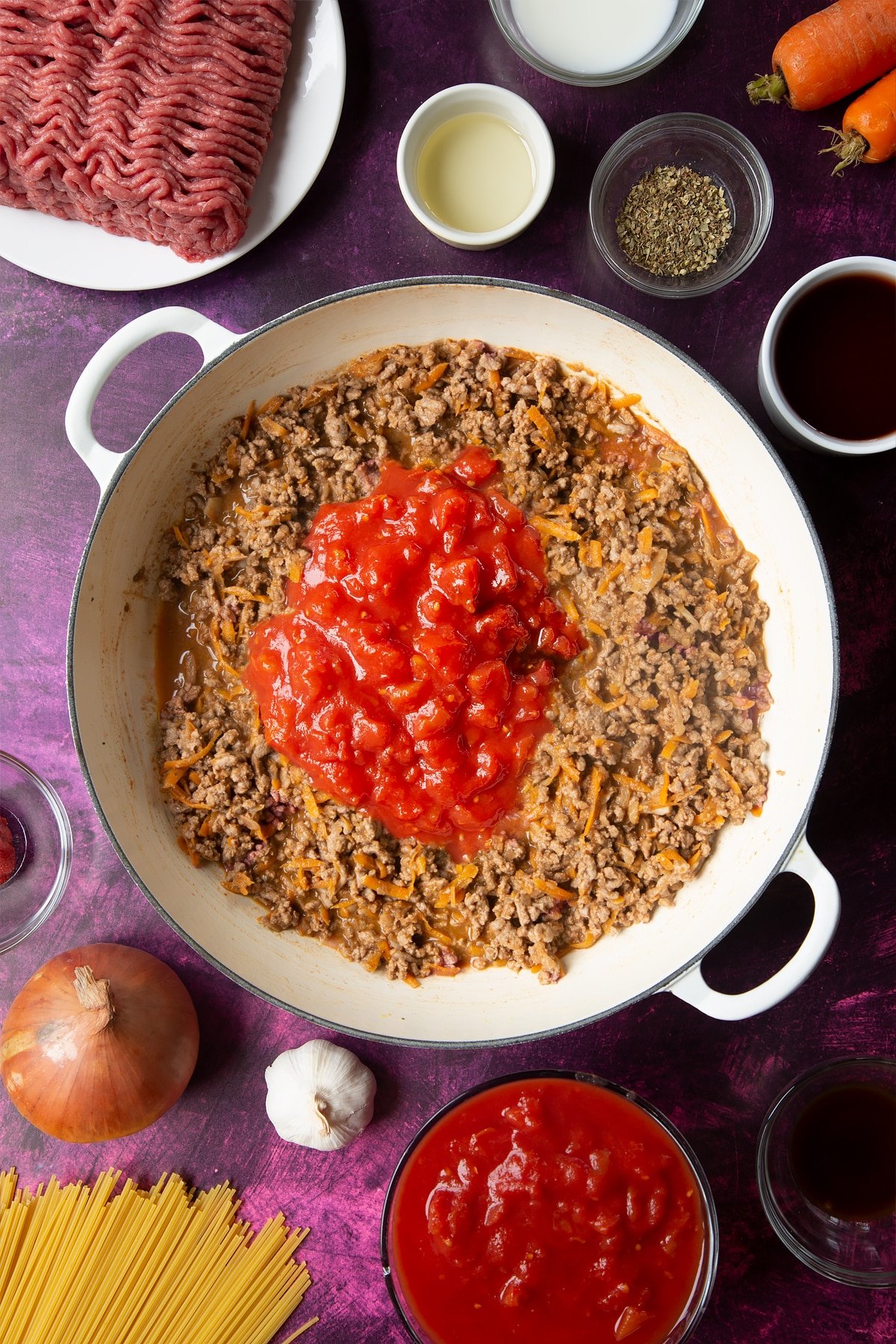
Stir and bring up to a simmer.
Now is a good time to put your pasta on to cook in plenty of boiling, salted water. I tend to cook for about 8 minutes, but your pasta may take longer. I tend to aim for 1-2 minutes below what's recommended on the pack as I like it with plenty of bite.

Simmer your bolognese for 5-6 minutes until it takes on a darker, richer colour and the tomatoes have no metallic taste.

Add the milk.

Stir through - this makes the sauce silky and rich.

Drain your spaghetti and serve to plates.

Spoon the bolognese on top and serve.

Enjoy! A few shavings of Parmesan wouldn't hurt!



Pointers, tricks and troubleshooting tips for the perfect spaghetti bolognese
Is spaghetti bolognese easy to make?
Making spaghetti bolognese Gordon Ramsay style is really easy, especially since you'll grate the veggies rather than chopping them.
You'll only need a single pan and the whole thing should be ready in under 20 minutes.
Will I need any special equipment to make spaghetti bolognese?
You don't need any special equipment to make spaghetti bolognese.
For the bolognese, you'll just need weighing scales, measuring spoons and a garlic press, a large frying pan and a silicone spatula.
For the spaghetti, you'll just need a large saucepan and a colander.
What is Worcestershire sauce?
Worcestershire sauce is a fermented condiment, made with vinegar, molasses, red onions, garlic, anchovies, tamarind and secret seasoning.
It's tangy with a salty-sweet, umami (savoury) flavour and is used to enhance of all sorts of dishes from cheese toasties to chilli con carne.
How can I tell if my beef mince has gone bad?
Minced beef has the potential to go off much more quickly than, say, a steak might because it has a much larger surface area. this means that much more of the surface may be exposed to oxygen can promote the growth of bacteria. And as you probably know, a growth of bacteria could lead to food poisoning.
Fresh beef mince should appear a vibrant dark pink or red depending on the fat quantity. As it becomes less fresh and begins to break down, it will lose that vibrant colour and look grey. That's a really good clue that your raw mince is past its best.
Other clues include the way it smells, so discard any mince that has an off or unusual odour. You may also see some slime on the surface which is another sign that your beef shouldn't be used.

All supermarket purchased beef will come with storage advice and a Use By date, which you should adhere to. If you're buying from a butcher, you can ask for their advice. As a general rule, you should put your beef mince in the refrigerator as soon as you get home from the supermarket and then use it within a day or two.
If you don't think you're going to be able to use your beef within that timeframe, it's best to freeze it to prevent the bacteria from reproducing
When you cook your beef mince, be sure to cook it all the way through. Unlike steak, which can be seared but left rare in the centre, beef mince has lots of surface area, so needs to be thoroughly cooked.
Of course, it's possible for beef mince to look perfectly healthy and still have been contaminated. That's why it's important to buy from suppliers who adhere to good standards of hygiene and food handling.
Is this spaghetti bolognese recipe suitable for vegetarians?
No, Gordon Ramsay makes bolognese using beef mince, meaning it's not suitable for a meat-free diet.
If you wanted to use this recipe to make a vegetarian recipe similar to Gordon Ramsay's, you could use vegetarian mince. Some vegetarian mince can be quite dry so you may need to add a little water or vegan stock.
You'll also need to leave out the Worcestershire Sauce, which contains anchovies. You could replace with half the quantity soy sauce, if you like.
Is this spaghetti bolognese suitable for vegans?
As Gordon Ramsay recommends using beef mince, this recipe isn't suitable for vegans.
If you wanted to use this recipe to make a vegan recipe similar to Gordon Ramsay's, you could use vegan mince. Vegan minces can be quite dry so you may need to add a little water or vegan stock.
You'll also need to leave out the Worcestershire Sauce, which contains anchovies. You could replace it with replace with half the quantity soy sauce, if you like.
Finally, you would need to either leave the milk out or try using a plant-based milk, although I haven't tried this.

Is this spaghetti bolognese gluten-free?
This recipe uses wheat-based spaghetti, but you could substitute this for gluten-free pasta.
Worcestershire Sauce can contain gluten, due to the way the vinegar in its ingredients is produced. You can get a gluten-free version of Worcestershire Sauce in the "free from aisle" of most major supermarkets.
Be sure to check the labels on all other ingredients to ensure they are suitable for a gluten-free diet.
Is this spaghetti bolognese keto-friendly?
Pasta is high in carbohydrates and so not suitable for a ketogenic diet. You could try serving with zoodles (courgette noodles) to reduce the carb content.
Is this spaghetti bolognese healthy?
This recipe is relatively high in carbohydrates (mainly thanks to the pasta), high in protein and relatively low in saturated fat.
It's suitable to enjoy as part of a healthy, balanced diet.
Is spaghetti bolognese safe to eat while pregnant?
There is nothing in this recipe that should present a risk to pregnant people if the ingredients are in good condition and have been stored correctly, and the recipe is cooked hygienically and safely.
A Mummy Too does not offer medical advice. You can review the NHS advice here and you should consult with your medical professional regarding any concerns.
Is spaghetti bolognese for babies and toddlers?
Weaned babies and young children will probably love this recipe, because it's flavourful yes quite soft for young palates.
However, I would leave out the wine, salt and Worcestershire sauce, especially for babies. You could add a little water, no-salt stock or tomato juice to make up for the missing liquid.
Always give food at an appropriate size and shape for your baby or child. Cut small, round foods, like grapes and cherry tomatoes, into small pieces.
Always keep babies supported upright while eating and supervise your baby when they’re eating in case they start to choke.
The NHS has some excellent advice on feeding babies.
This website does not offer medical advice: always consult your health professional if you have any concerns.

What goes well with spaghetti bolognese?
The spaghetti bolognese is incredible topped with a little Parmesan cheese.
You could also serve it with some green veg or a side salad. For a special treat, how about a little garlic bread?
Can I make this recipe without Worcestershire Sauce?
Yes, you can make this recipe with Worcestershire Sauce. It adds a really nice savoury depth to the flavour, but it's not essential. Either leave it out, or replace with half the quantity soy sauce.
Can I chop the veggies rather than grating them?
Grating the carrot and onion allows them to break down much more quickly, which shortens the cooking time. You can definitely chop them finely, if you prefer, but be sure to allow extra time to sweat them down until very soft.
Could I blend the vegetables in the food processor instead of grating?
Yes, you could puree the carrot and onion, if you like. It's not really necessary but should work fine as long as you ensure you still sweat them off. They'll be a puree right away, of course, but you need that sweating process to release the flavour and remove the raw onion flavour.
Can I make this recipe without milk?
Yes, you can leave the milk out if you like. Gordon Ramsay advises that adding the milk helps achieve a silky texture and in my tests, it worked well, but you can definitely leave it out and still have a lovely bolognese.
I haven’t got lean beef mince can I use full fat?
You can use full fat beef mince if you like, but it will release quite a lot of fat into your sauce, which wouldn't be very nice.
If you decide to use full fat beef mince, I'd recommend frying it on its own first until browned. Drain off the fat and then set it aside. Start the recipe as normal and add the cooked beef at the point you would usually add the lean beef mince.
Can I add extra vegetables to this recipe?
You can add extra vegetables to this recipe, if you like. A little extra grated onion and/or carrot shouldn't be a problem and would add extra flavour, sweetness and nutrients to the sauce.
You can add other veg, of course, but bear in mind that this bolognese doesn't simmer for very long (only about 6 minutes) so you'll need to opt for veg that cook quickly. How about adding a handful of garden peas towards the end of cooking? Or stirring in some wilted spinach?

How should I store spaghetti bolognese? Can I keep it in the refrigerator?
Yes, it's important to store any leftovers in the refrigerator rather than at room temperature.
Once cool, transfer to a sealed container and place in the fridge within two hours of making.
Can I leave spaghetti bolognese out on the counter?
No, it is important to place any leftovers in a sealed container in the fridge within 2 hours of making.
Can I make spaghetti bolognese ahead?
I'd recommend only cooking the spaghetti when you're ready to serve it, but you could certainly cook the bolognese the day before, if you like.
Follow the recipe then, instead of serving on to the pasta, cover and allow to cool completely. Once cool, transfer to an airtight container and store in the fridge, ready to reheat and serve the next day.
While your pasta boils, gently reheat in a pan on the stove, stirring regularly until piping hot all the way through. You may need to add a splash of water to loosen it back up.
Can I freeze spaghetti bolognese?
Yes, you can freeze spaghetti bolognese.
Ideally, freeze the bolognese sauce on its own in a sealed, freezer-safe container within 2-hours. Aim to fill the container up as much as possible as the less air there is in there, the less chance there is of freezer burn.
You can free the pasta too, if you like, or the two elements stirred together, but bear in mind that the pasta will probably be very soft when reheated.
How long does spaghetti bolognese keep?
Properly stored in a sealed container in the fridge, your spaghetti bolognese should keep for 3 to 5 days.
In the freezer, it should keep for up to 3 months.
What is the best way to reheat spaghetti bolognese?
If just reheating the sauce from chilled, decant into a pan and heat on a medium low stove, stirring regularly until piping hot all the way through. You may need to add a splash of water to loosen it back up.
Defrost frozen spaghetti bolognese in the fridge overnight before heating as described above.

Can I make this recipe in a different quantity?
It is super easy to make this spaghetti bolognese in a different quantity.
Simply scroll down to the recipe card towards the bottom of this post and hover your mouse (or tap your finger) over the portion number, which is showing as 6 by default.
You will then be shown a slider, which you can move up and down to change the number of portions the recipe will give. As you do so, all of the ingredient quantities will automatically change accordingly. Clever, right?
Of course, if you significantly reduce or increase the size of this recipe, it may affect the cooking time, so keep an eye on your bolognese as it simmers and use your judgement to decide how long it might need.
If you have any questions about changing the quantities, just ask!
Why did my spaghetti bolognese turn out bland?
With the cheat's soffritto base, the Worcestershire sauce, the wine, oregano and garlic, as well as the natural flavour of the beef and tomatoes, this recipe really shouldn't turn out bland - it should be rich and delicious.
If it's lacking in flavour, it could be that you mis-measured the quantities. Dried oregano can lose its flavour if it's very old, particularly if it's stored without its lid. Likewise, garlic can sometimes dry out and lose its strength.
Why did my spaghetti bolognese turn out greasy?
Make sure you use lean beef mince to avoid ending up with a greasy bolognese.
Why did my spaghetti bolognese turn out dry?
There's plenty of liquid in this recipe to allow for a rich bolognese. If yours turned out dry, it may be that a mistake was make when measuring your ingredients.
Alternatively, it could be that the heat on your stove was set too high. This could mean that the sauce boils rather than simmers, meaning too much moisture is lost.
If your sauce looks too dry during simmering, you can add a splash of water, tomato juice or stock.
How can I add/change the flavours in this dish?
This is a really great spaghetti bolognese exactly as it is, but if you wanted to alter it, you could try adding a few chilli flakes for some kick, or a handful of spinach for an earthy edge.
What is the origin of spaghetti bolognese?
Bolognese is a meat based sauce (ragù) that is typically served with pasta.
Bolognese is, of course, Italian in origin and records of ragù served with pasta in the Bologna region (hence, bolognese) date back at least as far as the 18th century.
However, serving bolognese with spaghetti is quite decidedly not typical of Italian cuisine. This is because spaghetti is considered too thin to hold on to the meaty sauce, so tagliatelle is preferred.
Furthermore, since the UK/US version of bolognese heavily features tomatoes as an ingredient, it actually more closely resembles Neapolitan ragù rather than Bologna ragù.
Nevertheless, in the early twentieth century, "spaghetti bolognese" as we know it today grew in popularity in both the US and the UK and has held its place ever since.
Print this Spaghetti bolognese Gordon Ramsay style recipe
Spaghetti Bolognese Gordon Ramsay Style Recipe
Ingredients
- 1 tbsp olive oil
- ½ (1/2) onion grated (about 100g/3.5oz)
- 1 carrot grated (about 100g/3.5oz)
- 4 cloves garlic minced
- 2 tsp dried oregano
- 500 g (1.1 lb) lean beef mince
- 2 tbsp tomato puree
- 150 ml (5.1 floz) red wine
- 800 g (1.8 lb) canned chopped tomatoes
- 2 tsp Worcestershire sauce
- 4 tbsp whole milk
- pinch salt and black pepper
- 300 g (10.6 oz) dried spaghetti
Instructions
- Heat the oil in a large non-stick pan over medium heat.
- Add the carrot and onion, give it a stir, then add the garlic, oregano and a pinch of salt and pepper.
- Sweat the vegetables off, stirring regularly for around 2 minutes until soft (almost paste-like) but not browned.
- Make a well by pushing the veggies to the sides of the pan, then add the mince to the centre. This allows the heat to get right to the mince.
- Stir the mince, frying for 2-3 minutes until it’s mostly browned.
- Make a well again and add the tomato puree. Stir for 30 seconds to allow the puree to cook off a little - that gets rid of the metallic taste, then stir everything together.
- Add the red wine. Cook for a couple of minutes until the wine reduces to a syrup.
- Add the tomatoes and Worcestershire sauce. Stir and bring up to a simmer.
- Now is a good time to put your pasta on to cook in plenty of boiling, salted water. I tend to cook for about 8 minutes, but your pasta may take longer. I tend to aim for 1-2 minutes below what's recommended on the pack as I like it with plenty of bite.
- Simmer your bolognese for 5-6 minutes until it takes on a darker, richer colour and the tomatoes have no metallic taste.
- Add the milk and stir through - this makes the sauce silky and rich.
- Drain your spaghetti and serve to plates, spoon the bolognese on top and serve.
Video
Notes
Nutrition
Pin this Gordon Ramsay style Spaghetti bolognese

More pasta recipes to try
Have you got my book?

'This is a great kids cookery book. Emily is a star' - Simon Rimmer
'The book I'd like to force into any mother's kitchen' - Prue Leith
"A fab book with a plan." - Jane Devonshire, 2016 Masterchef UK winner
'Emily has managed to combine her mummy knowledge and passion for food to make a truly helpful and brilliant cookbook' - Priya Tew, RD, BSc (Hons), Msc
Get Your Kids to Eat Anything is an achievable 'how to' for parents in the battle to overcome picky eating and 'make new the norm'. Emily Leary's unique 5-phase programme looks at the issue of 'fussy eating' in a holistic way that links imagination with food, and which situates parents alongside - not in opposition to - their children.
.

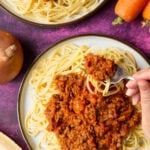





Phil C says
This was fantastic I used half beef, half pork, as well as fresh tomatoes from my wife's garden; the added wine was a lovely Mourvèdre, and I added a little grated nutmeg at the end. Rich and delicious.
Tom T. says
I didn't have any red wine so that would have improved it, but to be honest I found this recipe pretty bland. I'm no expert on Itallian food, but I know bland when I taste it. Kids were happy though. Nice pictures.
Will says
I find Italian food a bit bland so perhaps this version will be tastier!
Btw, my late wife used to make spaghetti meat sauce with cut-up smoked bacon and it truly made it more delicious. Anything to amp up the flavour is never a bad thing.
Emily Leary says
Sounds like a smart woman!
Rob Horne says
Mr Ramsey adds oil to his pasta water and that's all we need to know about his knowledge of how to cook any food from any Italian region. His scrambled eggs are good though.
Emily Leary says
Oil in pasta water?!!? So that the sauce doesn't stick? That's...interesting :-o
Rob Horne says
Indeed! 'How to cook the perfect pasta, Gordon Ramsey'.
But I also feel I should apologise, my comment was somewhat negative.
Thank you for taking the time to post this recipe :)
Emily Leary says
That's ok, Rob! Classic recipes are always divisive and this one is no exception, but it has been interesting to try it out and it is really rather delicious, even though not authentic. (I didn't put any oil in the pasta water though!)
Marzio Conti says
Nothing like a Bolognese sauce. Bolognese sauce never uses garlic or herbs. It might taste nice but you can never call it a Bolognese sauce. Crazy.
Kiria Pepe says
Well I have given your recipe 5 stars because it is innovative I guess, the recipe certainly isn't authentic, first of all no Italian would add 'milk' to a pasta sauce unless its a white sauce, and that would normally be served with some kind of fish or cheese, there are so many versions of Bolognese sauce. In Italy they just don't make it and assuredly not in the southern regions, where they either make a pasta sauce with or without meat, with each region having their own way and take on a basic Italian pasta sauce. I like Gordon Ramsey's way of cooking but I don't agree with everything he says, he always likes to put his own twist on recipes, and that's probably true of most chefs. The thing with cooking is that its an opportunity to be creative, there are no right or wrong ways unless your baking, in which case you need to be precise of course.
Emily Leary says
Thanks for this. I agree it's not authentic and I hope that came across in the write up. Your input is really interesting. It is a tasty pasta recipe, of course. I guess it's good that in calling it spaghetti bolognese, we acknowledge the Italian inspiration behind it, but on the other hand not so great in that it leads some people to think it sounds authentic! But such is the way in the UK and it's been called "spag bol" for so long, I don't think it's likely to change now :) Thanks again.
giovanni says
The ragu made in bologna absolutely includes milk to finish.
Ole says
That is absolutely true, both the Ragu and Bolognese from Bologna, both has added milk :)
Emily Leary says
Thank you!
Ole says
Both the Ragu and Bolognese from Bologna, both have added milk if you want it authentic :)
Emily Leary says
Good to know!